
Calabasas is a city in the southwestern region of the San Fernando Valley in Los Angeles County, California, United States. Situated between the foothills of the Santa Monica and Santa Susana mountains, 29.9 miles (48.1 km) northwest of downtown Los Angeles, Calabasas has a population of 22,491.

The San Fernando Valley, known locally as the Valley, is an urbanized valley in Los Angeles County, California. Situated to the north of the Los Angeles Basin, it contains a large portion of the city of Los Angeles, as well as several unincorporated areas; and the incorporated cities of Burbank, Calabasas, Glendale, Hidden Hills, and San Fernando. The valley is well known for its film studios such as Warner Bros. Studios and Walt Disney Studios. In addition, it is home to the Universal Studios Hollywood theme park.

West Hills is a suburban/residential community in the western San Fernando Valley region of the City of Los Angeles, California. The percentage of residents aged 35 and older is among the highest in Los Angeles County.
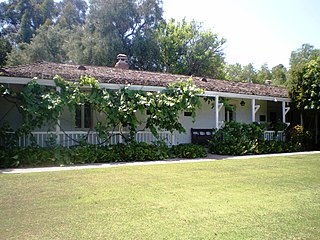
The Centinela Adobe, also known as La Casa de la Centinela, is a Spanish Colonial style adobe house built in 1834. It is operated as a house museum by the Historical Society of Centinela Valley, and it is one of the 43 surviving adobes within Los Angeles County, California. The Adobe was the seat of the 25,000-acre (100 km2) Rancho Aguaje de la Centinela, a Mexican Alta California-era land grant partitioned from the Spanish Las Californias era Rancho Sausal Redondo centered around the Centinela Springs.

Andrés Pico was a Californio who became a successful rancher, fought in the contested Battle of San Pascual during the Mexican–American War, and negotiated promises of post-war protections for Californios in the 1847 Treaty of Cahuenga. After California became one of the United States, Pico was elected to the state Assembly and Senate. He was appointed as the commanding brigadier general of the state militia during the U.S. Civil War.
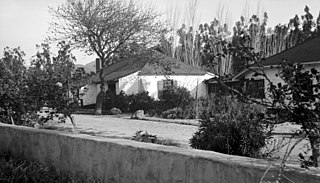
Rancho Camulos, now known as Rancho Camulos Museum, is a ranch located in the Santa Clara River Valley 2.2 miles (3.5 km) east of Piru, California and just north of the Santa Clara River, in Ventura County, California. It was the home of Ygnacio del Valle, a Californio alcalde of the Pueblo de Los Angeles in the 19th century and later elected member of the California State Assembly. The ranch was known as the Home of Ramona because it was widely believed to have been the setting of the popular 1884 novel Ramona by Helen Hunt Jackson. The novel helped to raise awareness about the Californio lifestyle and romanticized "the mission and rancho era of California history."
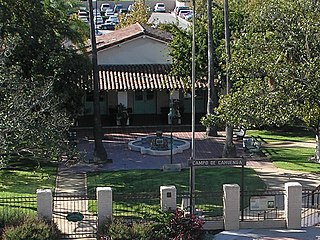
The Campo de Cahuenga, near the historic Cahuenga Pass in present-day Studio City, California, was an adobe ranch house on the Rancho Cahuenga where the Treaty of Cahuenga was signed between Lieutenant Colonel John C. Frémont and General Andrés Pico in 1847, ending hostilities in California between Mexico and the United States. The subsequent Treaty of Guadalupe Hidalgo of 1848, ceding California, parts of Colorado, Nevada, New Mexico, and Arizona to the United States, formally ended the Mexican–American War. From 1858 to 1861 the Campo de Cahuenga became a Butterfield Stage Station.

Bell Canyon is an unincorporated community in eastern Ventura County, California, United States. Bell Canyon is a gated community in the Simi Hills with the main access through the Los Angeles community of West Hills and the western San Fernando Valley. Bell Canyon sits at an elevation of 1,368 feet (417 m). The 2020 census reported Bell Canyon's population was 1,946. For statistical purposes, the Census Bureau has defined Bell Canyon as a census-designated place (CDP). According to a 2016 study, Bell Canyon is the seventh wealthiest community in the state of California with an annual median income of $230,000.
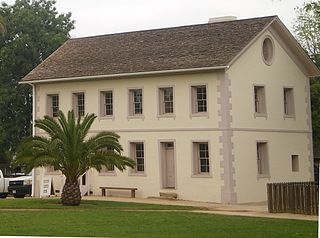
Los Encinos State Historic Park is a state park unit of California, preserving buildings of Rancho Los Encinos. The park is located near the corner of Balboa and Ventura Boulevards in Encino, California, in the San Fernando Valley. The rancho includes the original nine-room de la Ossa Adobe, the two-story limestone Garnier building, a blacksmith shop, a natural spring, and a pond. The 4.7-acre (1.9 ha) site was established as a California state park in 1949.
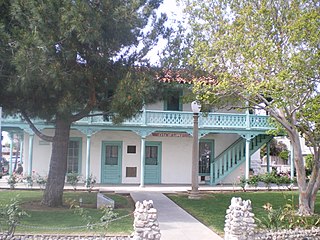
López Adobe, located at 1100 Pico Street in San Fernando, California, is one of the two oldest private residences in the San Fernando Valley. Built in 1882 by early settlers of the San Fernando Valley a short distance from the San Fernando Mission, it was listed on the National Register of Historic Places in 1971.

Rómulo Pico Adobe, also known as Ranchito Rómulo and Andrés Pico Adobe, was built in 1834 and is the oldest residence in the San Fernando Valley, making it the second oldest residence in Los Angeles. Built and owned by the Pico family of California, a prominent Californio family, the adobe is located in the Mission Hills section of the city and is a short distance from the San Fernando Mission. It was listed on the National Register of Historic Places in 1966.

The Minnie Hill Palmer House, also known as The Homestead Acre, is the only remaining homestead cottage in the San Fernando Valley. The cottage is a redwood Stick-Eastlake style American Craftsman-Bungalow located on a 1.3-acre (0.53 ha) site in Chatsworth Park South in the Chatsworth section of Los Angeles, California.

The Adamson House and its associated land, which was known as Vaquero Hill in the 19th century, is a historic house built by Rhoda Adamson and gardens in Malibu, California. The residence and estate is on the coast, within Malibu Lagoon State Beach park.

Shadow Ranch is a historic ranch house, built from 1869-1872 using adobe and redwood lumber, on the original Workman Ranch in the western San Fernando Valley of Los Angeles, California. For much of the 20th century it was in Canoga Park, but it is now within the boundaries of the West Hills community.

Los Angeles Historic-Cultural Monuments are sites which have been designated by the Los Angeles, California, Cultural Heritage Commission as worthy of preservation based on architectural, historic and cultural criteria.

The Orcutt Ranch Horticulture Center, formally known as Rancho Sombra del Roble, is a Los Angeles Historic-Cultural Monument located in the West Hills section of Los Angeles, California, USA.
Rancho Tujunga was a 6,661-acre (26.96 km2) Mexican land grant in the western Crescenta Valley and northeastern San Fernando Valley, in present-day Los Angeles County, California. It was granted in 1840 by Mexican governor Juan Alvarado to Francisco Lopez and Pedro Lopez.
Rancho El Escorpión was a 1,110-acre (4.5 km2) Mexican land grant in present day Los Angeles County, California given in 1845 by Governor Pío Pico to three Chumash Native Americans - Odón Chijulla, Urbano, and Mañuel. The half league square shaped Rancho El Escorpión was located at the west end of the San Fernando Valley on Bell Creek against the Simi Hills, and encompassed parts of present day West Hills and Woodland Hills.

María del Espíritu Santo Chijulla also known as Espíritu Chijulla; also spelled Chihuya; was an Indigenous Californian woman who became the first common-law spouse to win legal rights in California and inherited Rancho El Escorpión.

























